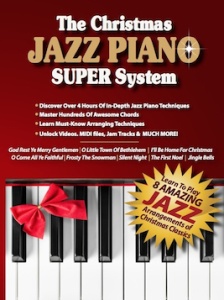Major Chords – How To Play Sweeter Sounding Chords
 Want to learn some beautiful ways of playing major chords? You’ve come to the right place.
Want to learn some beautiful ways of playing major chords? You’ve come to the right place.
As many fans of this site already know I’ll be releasing my brand new “Christmas Jazz Piano Super System” 2 DVD set on Monday November 3rd.
Since I made the announcement, I’ve received a TON of emails asking questions about the course. It’s been really amazing to see the excited responses from so many people.
I’ll be sharing the 1st free sample from “The Christmas Jazz Piano Super System” on this site about a week from today. So, make sure you check back to get access to it.
In the meantime, I wanted to share with you a free video today that will help you play much sweeter sounding major chords.
Free Major Chord Sweetener Video
Whether you are playing jazz tunes or Christmas music, if you want richer sounding major chords I think you’ll find this lesson extremely helpful.
Get started by watching this quick video below and then scroll down for some very important extra tips.
In jazz we play seventh chords the vast majority of the time. Much more so than just basic 3 note triads.
That being said, most professional jazz musicians treat basic 7th chords as just a starting point. In all actuality we’ll usually add even more notes on top of basic 7th chords.
These extra ‘color’ notes add a lot of richness and they make our chords sound much more interesting.
The concept behind these ‘color notes’ is known as chord extensions.
What Extensions Can You Play On Major Chords?
For the sake of this tutorial we’re going to call 1, 3, 5, and 7 basic chord tones. So, once you have your basic chord tones in place you can add 3 extensions to major chords.
Here they are in ascending order:
- The 9th.
- The #11th.
- The 13th.
Why Is The 11th Altered?
 As you heard me demonstrate in the video, the 11th is not a very pleasant sounding note on major 7th chords. It clashes with the 3rd of the chord. (They’re only a half step apart.)
As you heard me demonstrate in the video, the 11th is not a very pleasant sounding note on major 7th chords. It clashes with the 3rd of the chord. (They’re only a half step apart.)
So, instead we use the #11 as our extension of the chord. It’s a lot more pleasant sounding to the ear and doesn’t clash with the 3rd.
Of all the major chord extensions the #11 is definitely the most colorful and modern. You won’t necessarily here the #11 being used in a simple pop song.
It’s definitely ‘spicier’ than the other chord extensions. When used the right way, the #11 can be a truly beautiful note.
How To Apply Jazz Scale Theory To This Chord
Some people prefer to think in terms of scales. So, check out what happens when you line up all the basic chords tones and extensions in a row.
C, D, E, F#, G, A, B, C
1, 9, 3, #11, 5, 13, 7, 1.
All this together builds a famous scale called the lydian mode. This scale is one of the most common scales that people play on top of major chords.
Pretty cool how the chords and the scales tie together over a major chord right?
Turning Theory Into Real Music
Now, scale theory is important but ultimately at the end of the day it’s all about taking these chord extensions and applying them to real music. That’s where the magic happens.
So, once you get familiar with the major chord extensions you’ll want to practice using them inside a jazz tune.
Most jazz tunes have at least 1 major chord so you’ll have lots of opportunities to practice throwing them in.
If you want to watch how I use them inside tunes you can get access to hours and hours of in depth song tutorials and sheet music inside The Premium Membership Course.
Do You Have Questions?
If you have any questions on the major chord extension lesson please feel free to leave a comment below. I read every comment.
In the meantime, enjoy your practice and watch for the 1st sample of the Christmas Jazz Piano Super System DVD in about a week. Stay tuned!
Update: The first sample has been released. You can check out the first christmas piano song right here.
